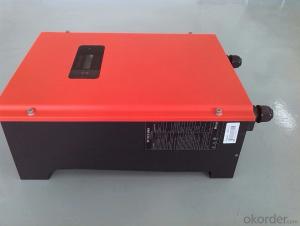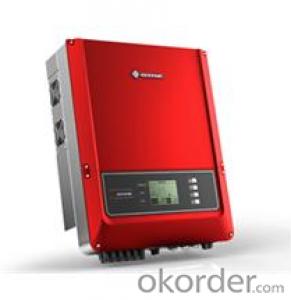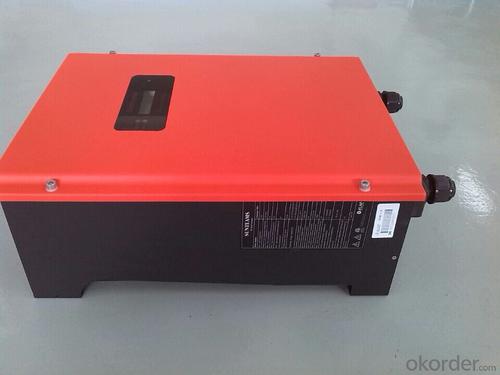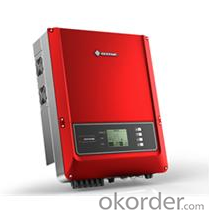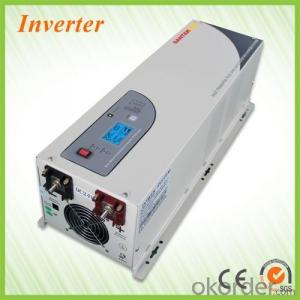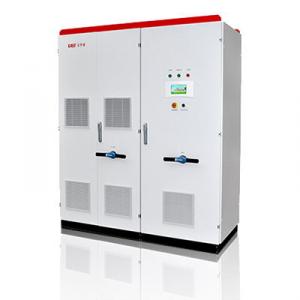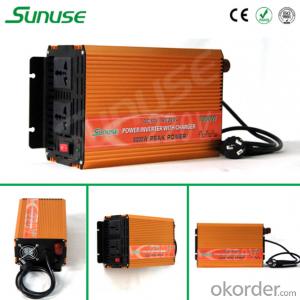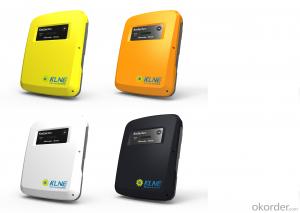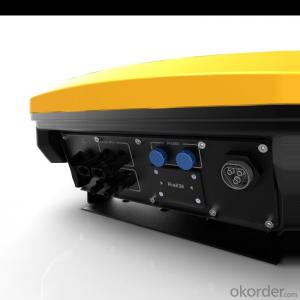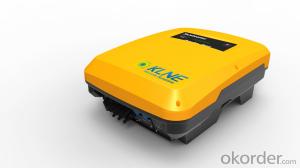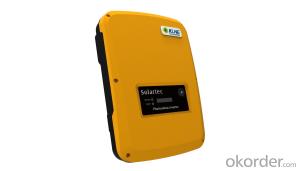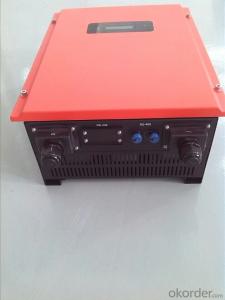Solar Inverter Specs - Off-Grid Type Solo-50 Series
- Loading Port:
- Shanghai
- Payment Terms:
- TT OR LC
- Min Order Qty:
- 10 unit
- Supply Capability:
- 1000 unit/month
OKorder Service Pledge
OKorder Financial Service
You Might Also Like
Product Description:.
This system can keep 3 energy-saving bulbs with 9W working 5 hours per day and a 5W radio working 4 hours a day.
Output voltage: 12V d. c.
It can work for 3 successive rainy days.
● System voltage:12V
Ø
● Charge and discharge current:10A
● Power:50W..
● Dimensions of box:300*220*270mm..
Ø
● Net weight of the box:5kg
Product Datasheet:
Main Accessories | Specifications | No. | Notes |
Box | High-quality rolled steel | 1 | Standard enclosure, optional colors |
PV modules | Polysilicon 50Wp | 1 piece | Optional |
Storage battery | Lead acid, maintenance-free,60Ah | 1 piece | Optional |
Controller | Solo-LS1024S 10A | 1 unit | Standard |
PV accessories shelf | Simple type | 1 set |
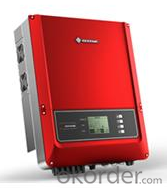
Product Advantages:
Powered by DC current
Can used out of doors
High effiency and low noise
FAQ
What is your payment terms?
We accept T/T payment, normally we need 20% T/T in advance, 80% payed before shipment.
What is your packing system?
We put the sistem in the wooden box.
Can you do OEM service?
Yes we can, but we need to do it with a certain order quantity.
- Q: What is the role of an anti-islanding function in a solar inverter?
- The role of an anti-islanding function in a solar inverter is to ensure the safety of utility workers and prevent damage to the grid during a power outage. It detects if the grid is down and immediately disconnects the solar system from the grid, preventing the solar inverter from continuing to operate and potentially backfeeding electricity into the grid. This functionality is crucial in maintaining grid stability and protecting personnel working on the power lines.
- Q: What is the role of voltage regulation in a solar inverter?
- The role of voltage regulation in a solar inverter is to ensure that the energy generated by the solar panels is converted and delivered to the electrical grid or used within a premises at a stable and appropriate voltage level. It helps to maintain the quality and consistency of the electricity output, protecting the connected devices and ensuring optimal performance of the solar power system.
- Q: Three-phase photovoltaic inverter grid, the use of phase-locked loop is what?
- Photovoltaic inverters for grid-connected photovoltaic power generation systems are primarily capable of receiving DC power from photovoltaic arrays and converting them into sine-wave currents of the same frequency and in phase with the access grid for powering the grid or local loads.
- Q: Can a solar inverter be used with a three-phase power system?
- Yes, a solar inverter can be used with a three-phase power system. In fact, many commercial and industrial solar installations utilize three-phase power systems to effectively distribute and manage the generated solar energy. A three-phase solar inverter is designed to convert the direct current (DC) produced by solar panels into alternating current (AC) that is compatible with the three-phase power grid. This allows for efficient power transmission and utilization of solar energy in three-phase systems.
- Q: Can a solar inverter be used for three-phase power systems?
- Yes, a solar inverter can be used for three-phase power systems. There are specific three-phase solar inverters available in the market that are designed to convert DC power from solar panels into AC power for three-phase electrical grids. These inverters are capable of synchronizing with the grid and distributing power across all three phases efficiently.
- Q: How does a solar inverter affect the overall system reliability in harsh environments?
- A solar inverter plays a crucial role in the overall system reliability in harsh environments. It acts as the heart of the solar power system, converting DC power generated by solar panels into AC power for use in homes or businesses. In harsh environments, such as extreme temperatures, high humidity, or excessive dust, a reliable solar inverter is essential to ensure uninterrupted power generation. A high-quality inverter with robust components and advanced protection features can withstand these harsh conditions, preventing system failures and maximizing the system's overall reliability.
- Q: Can a solar inverter be used in systems with different module voltages?
- Yes, a solar inverter can be used in systems with different module voltages by adjusting its settings or using additional components such as DC optimizers or power optimizers. These components help in matching the voltage of the solar modules to the input voltage range of the inverter, allowing for efficient power conversion.
- Q: How does a solar inverter handle different temperature conditions?
- A solar inverter is designed to handle different temperature conditions by employing various thermal management techniques. It typically has built-in cooling systems such as fans or heat sinks to dissipate excess heat. Additionally, advanced inverters may employ temperature sensors to monitor the internal temperature and adjust their operations accordingly. These temperature compensation features allow the inverter to maintain optimal performance and efficiency across a wide range of temperature conditions.
- Q: How do you calculate the total power capacity for a solar inverter?
- To calculate the total power capacity for a solar inverter, you need to consider two main factors: the maximum power output of the solar panels and the efficiency of the inverter. First, determine the maximum power output of the solar panels in watts. Then, divide this value by the efficiency of the inverter, usually given as a percentage. The resulting value will give you the total power capacity of the solar inverter in watts.
- Q: How does shading affect the performance of a solar inverter?
- Shading can significantly impact the performance of a solar inverter as it reduces the amount of sunlight reaching the solar panels. When panels are partially shaded, they generate less power, which in turn affects the output of the inverter. If a significant portion of the panels are shaded, the inverter may not be able to operate optimally or may even shut down. To overcome shading issues, technologies like bypass diodes or micro-inverters can be used, which minimize the impact of shading on overall system performance.
Send your message to us
Solar Inverter Specs - Off-Grid Type Solo-50 Series
- Loading Port:
- Shanghai
- Payment Terms:
- TT OR LC
- Min Order Qty:
- 10 unit
- Supply Capability:
- 1000 unit/month
OKorder Service Pledge
OKorder Financial Service
Similar products
Hot products
Hot Searches
Related keywords
